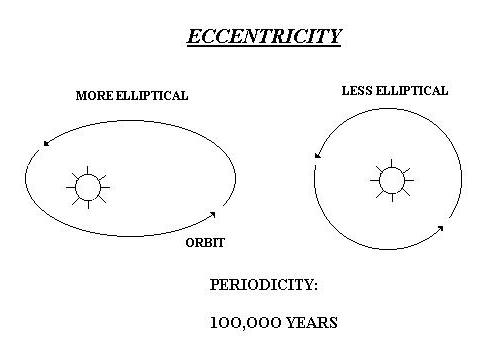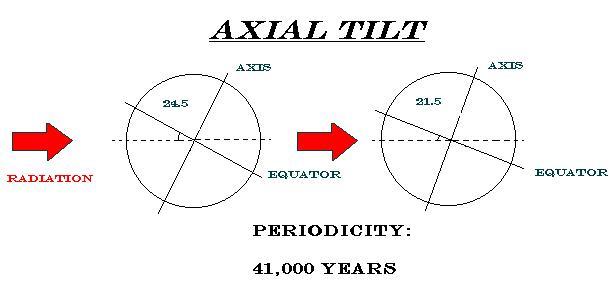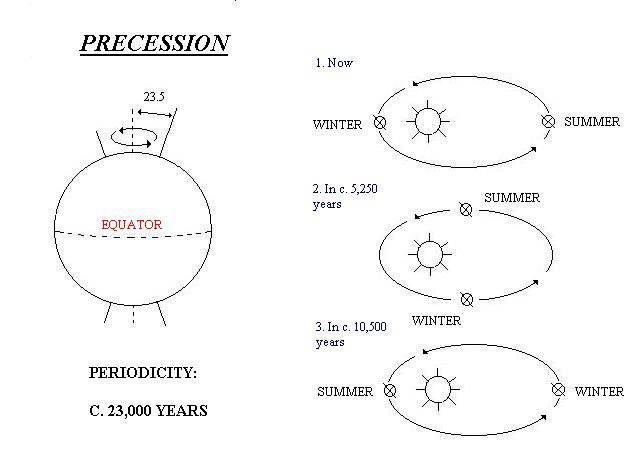The episodic nature of the Earth's glaciation periods within the present Ice Age (the last couple of million years) have been caused primarily by cyclical changes in the Earth's circumnavigation of the Sun.
Variations in the Earth's eccentricity, axial tilt, and precession comprise the three dominant cycles, collectively known as the Milankovitch Cycles for Milutin Milankovitch, the Serbian astronomer and mathematician who is generally credited with calculating their magnitude. Taken in unison, variations in these three cycles creates alterations in the seasonality of solar radiation reaching the Earth's surface.
These times of increased or decreased solar radiation directly influence the Earth's climate system, thus impacting the advance and retreat of Earth's glaciers.
It is of primary importance to explain that climate change, and subsequent periods of glaciation, resulting from the following three variables, is not due to he total amount of solar energy reaching Earth.
The three Milankovitch Cycles impact the seasonality and location of solar energy around the Earth, thus impacting contrasts between the seasons.
The combination of the long term Milankovitch cycles and the 11 year Sun Spot cycles covers the TWO MAJOR factors involved in Global Climate Change. Any other factors that the climate hoaxers claim effect GLOBAL climate is a joke.
Eccentricity is, simply, the shape of the Earth's orbit around the Sun. This constantly fluctuating, orbital shape ranges between more and less elliptical (0 to 5% ellipticity) on a cycle of about 100,000 years.
These oscillations, from more elliptic to less elliptic, are of prime importance to glaciation in that it alters the distance from the Earth to the Sun, thus changing the distance the Sun's short wave radiation must travel to reach Earth, subsequently reducing or increasing the amount of radiation received at the Earth's surface in different seasons.
Today a difference of only about 3 percent occurs between aphelion (farthest point) and perihelion (closest point).
This 3 percent difference in distance means that Earth experiences a 6 percent increase in received solar energy in January than in July. This 6 percent range of variability is not always the case, however.
When the Earth's orbit is most elliptical the amount of solar energy received at the perihelion would be in the range of 20 to 30 percent more than at aphelion.
The first of the three Milankovitch Cycles
is the Earth's Eccentricity.

At present the orbital eccentricity
is nearly at the minimum of its cycle.
These continually altering amounts of received solar energy around the globe result in prominent changes in the Earth's climate and glacial regimes.
Axial Tilt, the second of the three Milankovitch Cycles, is the inclination of the Earth's Axis in relation to its plane of orbit around the Sun. Oscillations in the degree of Earth's axial tilt occur on a periodicity of 41,000 years from 21.5 to 24.5 degrees.

At present, axial tilt is in
the middle of its range.
Today the Earth's axial tilt is about 23.5 degrees, which largely accounts for our seasons. Because of the periodic variations of this angle the severity of the Earth's seasons changes.
With less axial tilt the Sun's solar radiation is more evenly distributed between winter and summer. However, less tilt also increases the difference in radiation receipts between the equatorial and polar regions.
One hypothesis for Earth's reaction to a smaller degree of axial tilt is that it would promote the growth of ice sheets.
This response would be due to a warmer winter, in which warmer air would be able to hold more moisture, and subsequently produce a greater amount of snowfall. In addition, summer temperatures would be cooler, resulting in less melting of the winter's accumulation.
Precession is the Earth's slow wobble as it spins on axis. This wobbling of the Earth on its axis can be likened to a top running down, and beginning to wobble back and forth on its axis.
The precession of Earth wobbles from pointing at Polaris (North Star) to pointing at the star Vega.
When this shift to the axis pointing at Vega occurs, Vega would then be considered the North Star. This top-like wobble, or precession, has a periodicity of 23,000 years.
Due to this wobble a climatically significant alteration must take place. When the axis is tilted towards Vega the positions of the Northern Hemisphere winter and summer solstices will coincide with the aphelion and perihelion, respectively.
This means that the Northern Hemisphere will experience winter when the Earth is furthest from the Sun and summer when the Earth is closest to the Sun.
This coincidence will result in greater seasonal contrasts.
The third and final of the Milankovitch
Cycles is Earth's Precession.

At present, the Earth is at perihelion and
is very close to the winter solstice.
DECLINE OF THE UNIVERSITIES IN THE USA
America's education’s professional schools in medicine, business, math, science, and engineering are the world’s best. However, a liberal-arts major no longer certifies that a graduate will be able to read, reason, compute, or draw on a body of knowledge better than those without a degree. "The decline of the university has been an ongoing tragedy since the 1960s, but the erosion has accelerated because of ideological bias and its twin, incompetence."
Read the Full Article by Victor Davis Hanson
I apologize for the climate scare
Dr. Roy Spensor
Global Warming 101
JD Heyes
Proof It's A Hoax
More Fraud By Climate Alarmist
CO2 Does NOT Trap Heat
And FYI: Read
Fallacy Of Green Energy
By Clive Best
How Climate Data Is Faked
Film Clip Here
Tonny Heller
No Climare Crisis
Then There's George Carlin
Saving The World
The Crisis Is Real
Are You Prpared?
